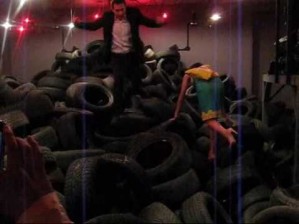
| Allan Karpow’s ‘YARD’ piece has been re-played through the artist by performance artist William Pope L., at the Manhattan townhouse 32 East 69th Street where Kaprow first exhibited his Environment YARD in 1961.
The scene presented Allan Kaprow YARD, revisiting a seminal 1961 work by the revered New York City-born artist and inventor of Happenings and Environments, whose intellectually rigorous site-specific, impermanent works defied commoditization and ultimately gave birth to performance and installation art. Until his death in 2006, Kaprow incorporated improvisation and public participation within and beyond the traditional museum and gallery context, influencing generations of other artists. “Life is much more interesting than art,†he wrote. “The line between art and life should be kept as fluid, and perhaps indistinct, as possible.†(via FAD) |

Allan Kaprow. Yard. View of tires in court of Martha Jackson Gallery, New York 1961. / img via Hauser & Wirth |
| review from NYT: Changing Un-Art’s Tires by Ken Johnson
IN 1961 Allan Kaprow, a pioneer of the Happening and forefather of today’s installations and performance artists, filled the walled-in backyard of the Martha Jackson Gallery with car tires and objects wrapped in black tarpaper. Visitors were invited to climb on the tires and move them around. He called it “Yard.†|
|
| This month the performance artist William Pope.L is to become the first of three artists to recreate — or, as the news release says, “reinvent†— “Yard.†He’ll work on the same site, newly occupied by the Swiss mega-gallery Hauser & Wirth. The property no longer has an open backyard, but Mr. Pope.L will fill the exhibition space with 1,200 tires.
He plans some alterations to Kaprow’s original concept. Instead of objects wrapped in tarpaper there will be stacks of black body bags, seemingly filled. Also, the tirescape will be animated by lights and mirrors, and accompanied by the sound of distant train whistles and, according to the gallery notes, “a voice evoking the cadences of Barack Obama reading a poetic and politically inflected text that recontextualizes Kaprow’s own instructions to ‘rearrange the tires.’ †Two other artists will also reinvent “Yard,†but elsewhere: Josiah McElheny, known for conceptually provocative re-creations of antique glassware, will present a billboard-size aerial photograph of a tire graveyard at the Queens Museum of Art (Oct. 1 to 3); and Sharon Hayes, whose performances, installations and videos deal with memory and history, will create her own version at the New York City Marble Cemetery in the East Village (Oct. 23 to 27). Inspired by Kaprow’s poster for his installation — an image of a roughly painted yard-sale sign that simply says “Yard†— Ms. Hayes plans to augment a landscape of tires with a variety of hand-painted signs, large and small. Organized by Helen Molesworth, curator of contemporary art at the Harvard Art Museums, the three-pronged project raises intriguing philosophical questions, like how such reinventions relate to Kaprow’s legacy. Kaprow, who died in 2006, welcomed the re-creation of his works by others. He regarded his ephemeral productions as musical compositions that could be performed repeatedly by different players, and was happy for others to add their own improvisations. He himself reproduced “Yard†several times in other locations. A purist might argue that however the reinventions turn out, there is an aspect that Kaprow might not have condoned. It is hard not to see the whole thing as a publicity stunt using the name of an artistic hero — a veritable saint of the avant-garde — to advertise the New York arrival of Hauser & Wirth, one of the richest purveyors of contemporary art. And publicity is something that Kaprow studiously avoided, especially after the mid-1960s, by which time Happenings had become a popular cultural phenomenon. Kaprow stopped using the term to describe his own activities. Instead he called what he did experimental art or “un-art,†and he abjured anything that could be considered conventionally artistic. He moved toward private, intimate, absurdist actions that only he and other participants (in some cases there were no other participants) knew about at the time they were occurring. In one he traded buckets of dirt with other people. In another he and a friend agreed to wash each other’s kitchen floors using only Q-tips and saliva. He wanted to do things in the context of life — not the museum or gallery — that were like life but different enough to alter his and others’ experience of the world. As he saw it, anything identifiable as art was too easily slotted into an exhausted category. We learned about the things he did because he talked and wrote about them, but he didn’t document them, and he had nothing to sell. (He supported himself by teaching.) Kaprow’s later activities were closer to a kind of Zen-like, consciousness-raising practice than what passes for performance art today. What he would have thought of the Hauser & Wirth extravaganza we’ll never know, but he once wrote that “achieving a respected place in a museum or opera house nowadays may be flattering, but it is pointless, because it reframes the lifework as conventional art.†This article has been revised to reflect the following correction: Correction: September 20, 2009 |
|
